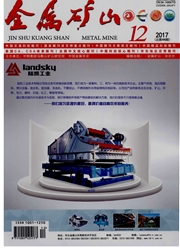

 中文摘要:
中文摘要:
以氧化亚铁硫杆菌为实验菌株,研究了黄铁矿的Fe^3+氧化和生物氧化过程中溶液铁离子浓度、pH值以及肌值的变化。结果表明,Fe^3+由于自身很快会被消耗,因而对黄铁矿的氧化速率较低;而在细菌的作用下,Fe^2+可以不断被氧化成Fe^3+,从而使黄铁矿的氧化速率明显加快,因此生物氧化具有更高的效率。基于间接作用机制,结合黄铁矿生物氧化过程中pH值及肌值的变化规律,提出了黄铁矿生物氧化的阶段性特点,即将氧化亚铁硫杆菌对黄铁矿的氧化过程分为黄铁矿无机氧化、Fe^2+生物氧化和黄铁矿稳定生物氧化3个阶段。
 英文摘要:
英文摘要:
The change in the iron ion concentration, pH and Eh in the Fe^3 + oxidization and bio-oxidation process of pyrite is studied by using Acidithiobacillus ferrooxidans. The results show that as Fe^3 + will rapidly be consumed, it has a low oxidation rate for pyrite while the presence of bacteria can continuously oxidize Fe^2+ into Fe^3 + , thus evidently accelerating the pyrite oxidation rate. Therefore, bio-oxidation has higher efficiency. Based on the indirect function mechanism and in light of the change law of pH and Eh in the bio-oxidation process of pyrite, it is suggested that the phase characteristics of pyrite bio-leaching can be divided into three phases, namely, phase Ⅰ ( inorganic oxidation of pyrite), phase Ⅱ ( bio-oxidation of Fe^2+ ) and phase Ⅲ( equilibrium bio-oxidation of pyrite).
 同期刊论文项目
同期刊论文项目
 同项目期刊论文
同项目期刊论文
 期刊信息
期刊信息
